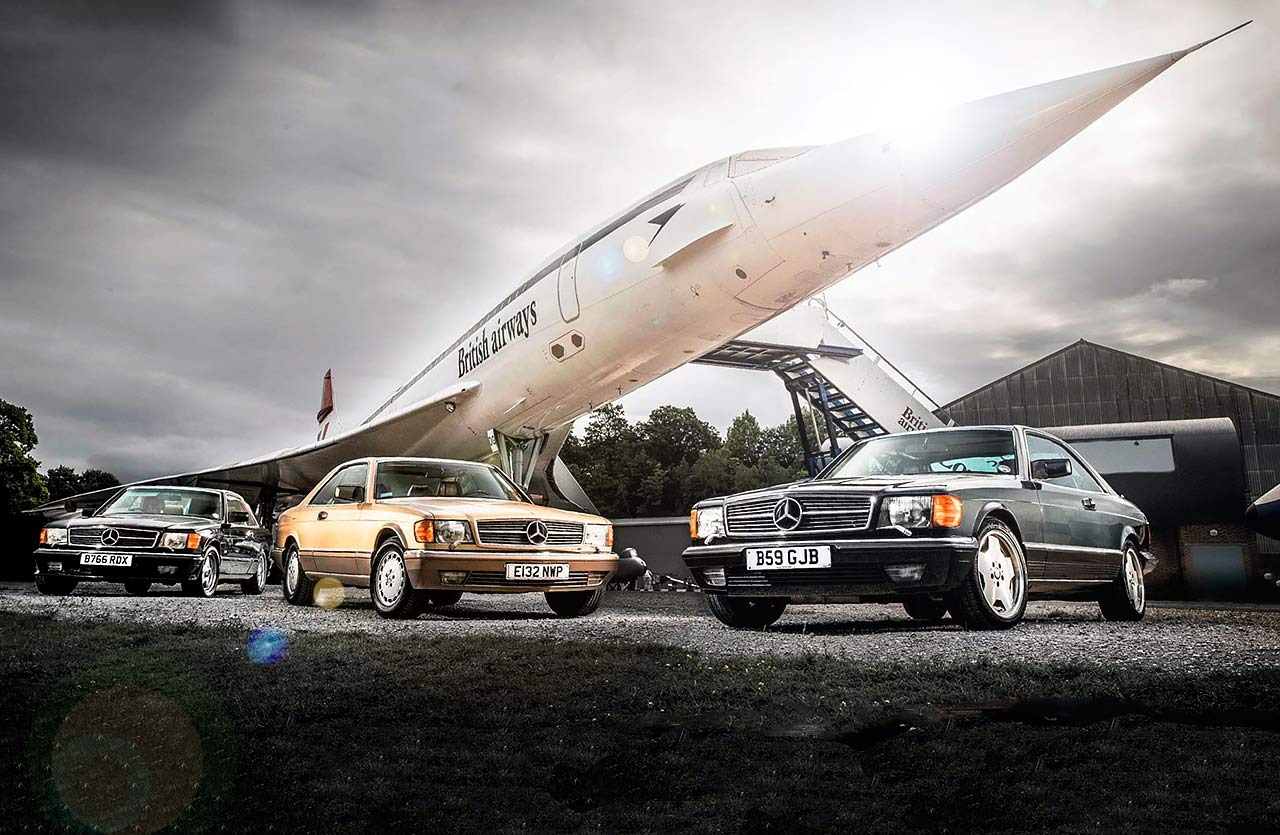
VIP specs SECs Senna, Mansell and Rosberg’s Mercs. Reliving Eighties F1 with the ex-Senna, Manseil and Rosberg Mercedes SECs. We drive the Mercedes-Benz SEC C126 coupes bought new by Ayrton Senna, Keke Rosberg and Nigel Mansell, and revel in how each car retains spine-tingling traces of its first owner’s character. What does a 1980s F1 racer drive on their day off? For Senna, Mansell and Rosberg, it had to be a three-pointed star – we drive their Mercedes-Benz SECs. Words: Emma Woodcock. Photos: Charlie Magee & Laurens Parsons.
Upscale downtime
Concorde towers above us, all length, line and speed. Fated to stand forever as a monument to its own achievements, the plane echoes a final golden era where progress could be measured in oil and metal, not silicon and click-throughs. An era where a cruising speed of 1354mph could be pursued for no purpose but speed itself.

Down on the ground, while the skies were filled with the sonic booms of businessmen thrusting between London and New York, Formula One was also enjoying a halcyon period of giddying speed and ever-increasing power. This was a time when Ayrton Senna was driven into a sustained out-of-body experience while qualifying for the 1988 Monaco Grand Prix, when Nigel Mansell repeatedly hurled his car around the outside of opponents in corners to take victory, and when Keke Rosberg took the Silverstone lap record beyond 160mph with a deflating tyre. Their tales of strength and bravery remain – like Concorde – as icons of a lost age.
When looking for road cars, however, these rock-ribbed racers were less concerned with ultimate performance. Many opted instead for the luxury of a large Mercedes, no doubt enticed by the generous deals the firm is said to have offered F1 drivers. The second-generation S Class coupe would prove to be the model of choice amongst the paddock. Introduced in 1979, the C126 immediately sent shockwaves through the market by combining a spacious, light interior with redoubtable build quality.
Extensive innovation helped to differentiate the Mercedes from its competitors, with seatbelt pretensioners, heated seats, a standard driver’s airbag and optional passenger airbag all debuting in the model. Second-generation ABS and cruise control also featured. Add the owner’s choice of straight-six or V8 engine, lashings of leather and walnut burr grain and you’ve got one of the grandest recipes in modern-classic motoring. The result is wrapped in crisp styling by Mercedes stylist Bruno Sacco. With an oversized grille badge, taut shoulder lines and bold rear pillars, it remains a fresh design and one instilled with the spirit of its age.
Any SEC is special but the three examples we have brooding under Concorde’s delta wing are further set apart by their motor sport links – the 1982 500 SEC was owned by Keijo ‘Keke’ Rosberg, the 1984 500 SEC by Ayrton Senna, and the 1986 560 SEC C126 by Nigel Mansell. Thanks to the tireless work of their owners and Mercedes historian Richard Mason, this marks the first time the trio has been brought together – and we’re about to drive them.
All eyes are immediately drawn to the oldest example, the C126 500 SEC owned by 1982 driver’s champion Keke Rosberg between 1982 and 1984. It sears against the fuselage, exaggerated angles and ink-black paint rendering it as symbolic of jetset extravagance as the plane it lounges beneath. With one of the flashiest guys in F1 on the logbook it makes sense that this SEC commands attention, thanks to extensive aftermarket modification.
The work was carried out by Carat by Duchatelet, a Belgian firm that then specialised in outfitting Mercedes with interior upgrades and bodykits. The full exterior conversion applied to the Rosberg SEC includes more aggressive front and rear bumpers, a rubber rear spoiler, side skirts and an extended rear light strip. Together with a set of 16-inch, five-spoke Carat by Duchatelet Momo alloys, it creates an angular, brooding presence unlike any other SEC.
One photo of Keke with the car exists, chronicling the car’s delivery in 1982. However, it shows that the 500 was visually standard with Signal Red paint at that time. The next extant document, a registration certificate from four years later, shows that the car had been repainted in its current hue by 1986 but no paper trail exists to show exactly when this change occurred.
The same registration document throws up another question because it records the SEC as boasting the 5.5-litre engine it currently carries. This larger variant of M117 wasn’t available until 1986, so it seems that this modification occurred under the second owner. However, the engine and chassis numbers curiously match one another. Suggests Richard Mason, ‘Often when Mercedes were imported to the UK the chassis number was also used as the engine number because it was impossible to locate and read the number on the engine.’
Puzzles aside, drop into the interior and all confusion floats away. Cream leather caresses every surface, from the seats to the A-pillars to the oversized Carat headrests, with softness and suppleness that easily surpass that of the Mercedes-trimmed SECs. Thick sheepskin carpets and a walnut gearlever increase the air of luxury, while the smaller span and thicker rim of the four- spoke Carat wheel raise hopes of a sporty drive.
Twist the key and those expectations are instantly met by the fluty, arrhythmic grumbling from the twin exhausts. Flick-ca-click down to drive and breathe on the throttle; the engine note rises to a wavering, mellifluous growl. Yet the note soon dies, smothered by the transmission slumping into third; I manually override back into second. The revs rise, the economy meter slings towards the red and the exhaust is back, high-pitched and racy. At 3000rpm the torque swells, squatting the car onto its rear springs and lightening the steering. Add 500 revs more and the engine note hardens to a serrated roar as the car surges towards the horizon.
When that skyline starts to buck and bend, it soon becomes clear that this SEC is more than a straight-line hero. Though light around the straight ahead, the steering quickly weights up through a corner, while the suspension chatters back through the chassis with information about the road below. There’s less of the luxury that defines the other cars but in its place comes engagement and an increased sense of security over crests and bumps, thanks to the car’s firmer springing. The shrunken wheel makes things better still, effectively quickening the steering because even a small wrist-flick produces a response from the front end. Delinquence has replaced decorum – and it’s an absolute riot!
Two years after Rosberg, Ayrton Senna took delivery of his new SEC. Though it looks like any other 500, there are claims that the Brazilian ordered his car with modifications to the camshafts and ECU, applied by Mercedes itself. Mercedes Classic could not confirm this but current owner Mike Bruno lends credence to the claims. ‘We took the top off the engine when we first got it,’ he explains, ‘and the cams are noticeably more aggressive than those in a standard 500. Open it up and it sings; there’s a lot more power than in the standard SECs I’ve driven.’
With the road opening up ahead of me, it’s time to put that assertion to the test. Slide into manual override, send the throttle to the floor and… wait. Very little happens at first, the car pottering up to 25mph with barely a murmur. The exhaust begins to bark but acceleration initially remains flatter than the other SECs, perhaps because of the thinner torque curve of this car’s 5.0-litre engine. Pass 3750rpm and the car finally wakes up, pulling with similar strength and greater urgency than its 5.5-litre counterparts. Perhaps Senna did request an upgrade.
Clinging onto the steering wheel he held, foot hard down on the accelerator pedal he buried, thoughts quickly turn to how Senna hustled the SEC during his ownership. With my rather less talented hands on the wheel, this C126 feels every inch the fast tourer through the turns. What the steering lacks in feel it makes up in a quick, precise action, though the wide-splayed wheel can leave you scrambling in tighter turns. Soft suspension encourages a slow-in, fast-out approach to quicker corners, the car hanging in animation for a breath before leaning into its outside tyres. Strong, feelsome brakes and good grip make for reassuring progress once a rhythm is established but you could never call it sporty.
Steve Bennett, a journalist who rode along in this car with Senna during a 1986 photoshoot, is quick to assure me that racer’s skills could draw far more from the car. ‘He took some big risks – sliding, hooning around and overtaking huge lines of stationary traffic before forcing his way back in. On roundabouts he’d try to get it sideways by using a huge tug on the steering wheel and a massive bung of throttle. I wasn’t at all scared but then I’d never driven like that with anyone on the road before!’
The third car of our champion-owned triptych exudes a more genteel air – watercolour bronze draping unadorned bodywork, edged by brown lower mouldings that were unridged on the 560. The 15-inch, 15-hole alloys are another model indicator, ensconced in huge doughnuts of rubber that hint at absolute comfort.
Mansell registered his SEC in the UK in 1988, three years after it had been constructed as an early, pre-facelift example of the 560 model. ‘Like many F1 drivers who had these cars, I imagine he collected it from the factory,’ hypothesises Mason. ‘In all probability Mansell’s SEC had similar (oval, Western Germany) plates to Senna’s car, enabling him to drive it all over Europe. Late in 1987 Nigel suffered concussion of the spine, so it’s likely the SEC sat around in Europe for some months before he brought it to the UK to be registered here. He used it to travel to races in Europe, hence the left-hand drive but mph-only speedometer.’
Before passing into the ownership of Mercedes-Benz UK in 2011, the car spent a decade under the stewardship of late intellectual art critic Brian Sewell, who used it to cruise around Europe in two television series – The Naked Pilgrim and Grand Tour. ‘He used to take the SEC on long continental trips,’ says Mason, ‘by all accounts driving in bare feet. He was passionate about cars and there are many quotes of his extolling the grace of the SEC. He often said the car would outlive him, and was right.’
As I drop the gearlever into drive the car oscillates on its haunches for a moment, a subtle initial sign that this car is less interested in sporting pretensions than the two 500s. Mansell’s SEC also stands out by remaining factory-standard, the 560 featuring a very similar specification to the earlier 500. The slight bump in volume creates a corresponding and meaningful uplift in peak power and torque, which stand at 268bhp and 317lb ft. Pull away and the 4G automatic transmission takes up smoothly, shuffling into third with a momentary burr from the engine ahead.
At 30mph complete silence is disturbed only by a minor swish of tyre noise. Bumps and lumps send minor squishes of compression through the structure but they hardly bother me, so well are their hard edges cushioned by the compliant suspension. Arrive on more open roads and the impression of luxury continues; travel two-thirds into the throttle and the 560 simply gathers speed with remarkable persistence. The soundtrack rises to a muted, persistent baritone, the car continues to hold its gear and pulls consistently from the middle of the rev range.
Only the most aggressive stamp of the pedal triggers the kickdown button on the floor. The steering, numb and flighty compared to the other SECs, sits even lighter between my fingers; it’s a game of nerve to keep away from the brake pedal as a corner approaches. A heaving sway and disinterested front end characterise the cornering experience and, while trailing the brakes into a corner adds some weight to the steering, the controls never really come alive. Better to aim for straighter, quicker roads and enjoy the long-limbed cruising where all three SECs excel.
As the miles glide by, you grow to understand what the Formula One drivers saw in these big coupes. You soon realise too what enchanted the art critic, the Conservative party speech writer, the lower-league racing driver, the property developer and the nightclub owner who have all since owned one of these three cars. Each feels like they could go on forever with an imperiousness unmatched in modern cars.
And if that’s not a fitting tribute to a period that valued speed and power above all, I don’t know what is.
Tech and photos
TECHNICAL DATA FILE SPECIFICATIONS 1982 Mercedes-Benz 500 SEC C126
Engine 4973cc V8, 16 valves, Bosch KE-Jetronic fuel injection
Max Power 228bhp @ 4750rpm / DIN nett
Max Torque 299lb ft @ 3000rpm / DIN nett
Transmission Four-speed automatic, rear-wheel drive
Suspension
Front: independent by double wishbones, coil springs and anti roll bar
Rear: independent by semi-trailing arms, coil springs and anti-roll bar
Steering Worm and sector
Brakes Ventilated discs front, solid discs rear, servo-assisted with ABS
Weight 1610kg (3549lb)
Performance Top speed: 140mph; 0-60mph: 7.3sec
Fuel consumption 15mpg
Cost new £28,700 (1982 UK)
Classic Cars Price Guide £3500-£13,500 (2018 UK)
TECHNICAL DATA FILE SPECIFICATIONS 1986 Mercedes-Benz 560 SEC C126
Engine 5547cc V8, 16 valves, Bosch KE-Jetronic fuel injection
Max Power 268bhp @ 5000rpm / DIN nett
Max Torque 317 lb ft @ 3750rpm / DIN nett
Transmission Four-speed automatic, rear-wheel drive, limited-slip differential
Suspension
Front: independent by double wishbones, coil springs and anti roll bar.
Rear: independent by semi-trailing arms, coil springs and anti-roll bar
Steering Worm and sector
Brakes Ventilated discs front, solid discs rear, servo-assisted with Bosch ABS-4-chanel
Weight 1760kg (3880lb)
Performance Top speed: 155mph; 0-60mph: 6.8sec
Fuel consumption 13mpg
Cost new £52.185 (1986 UK)
Classic Cars Price Guide £4500-£16,000 (2018 UK)
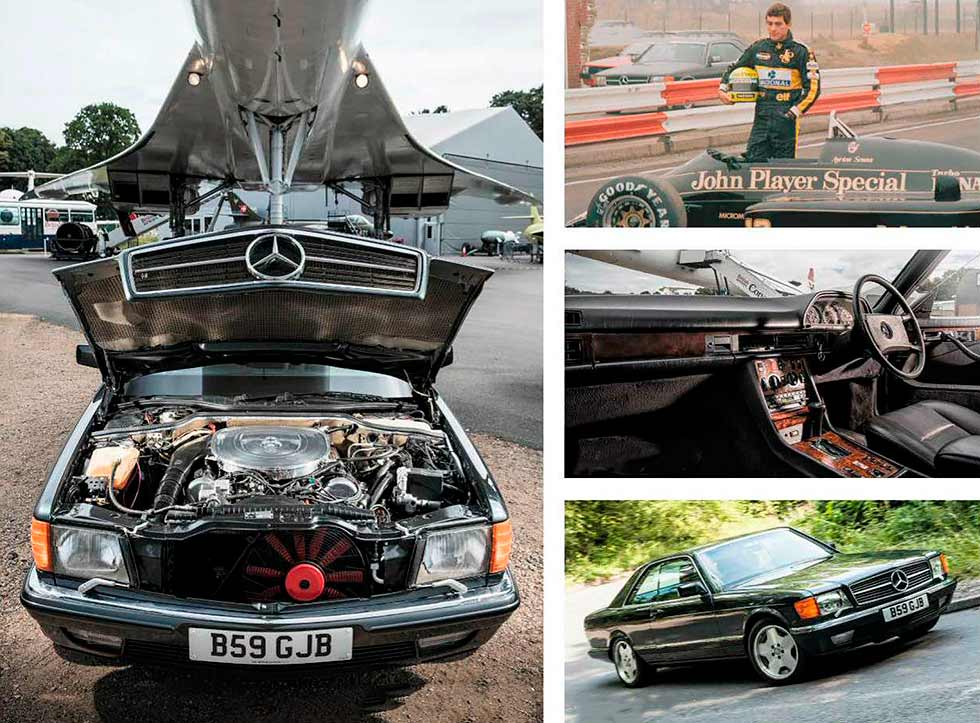
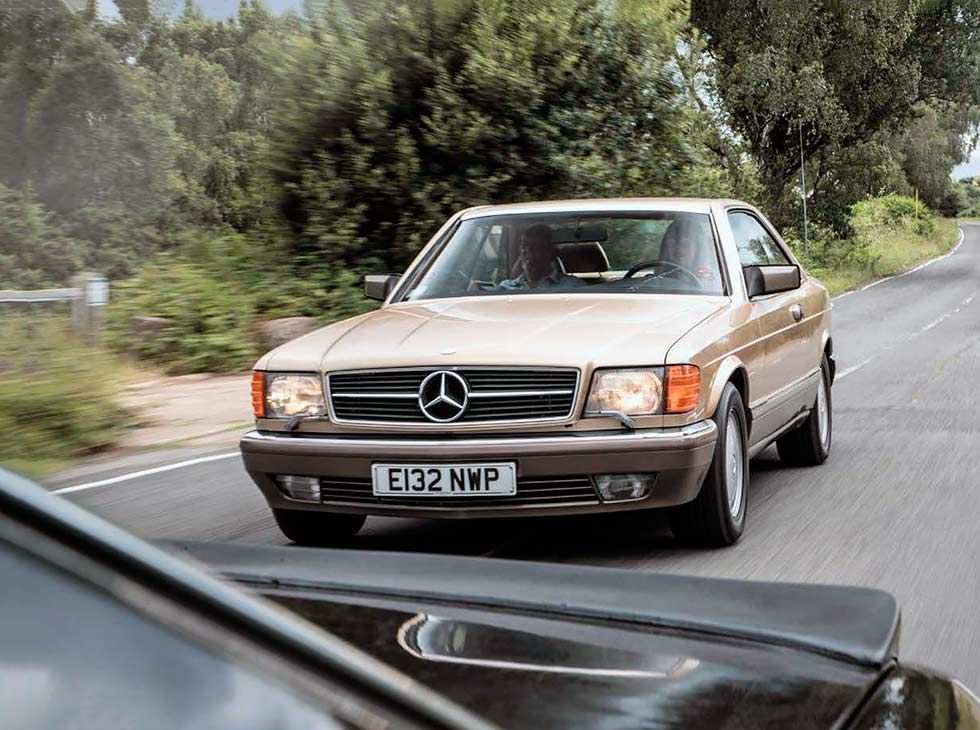
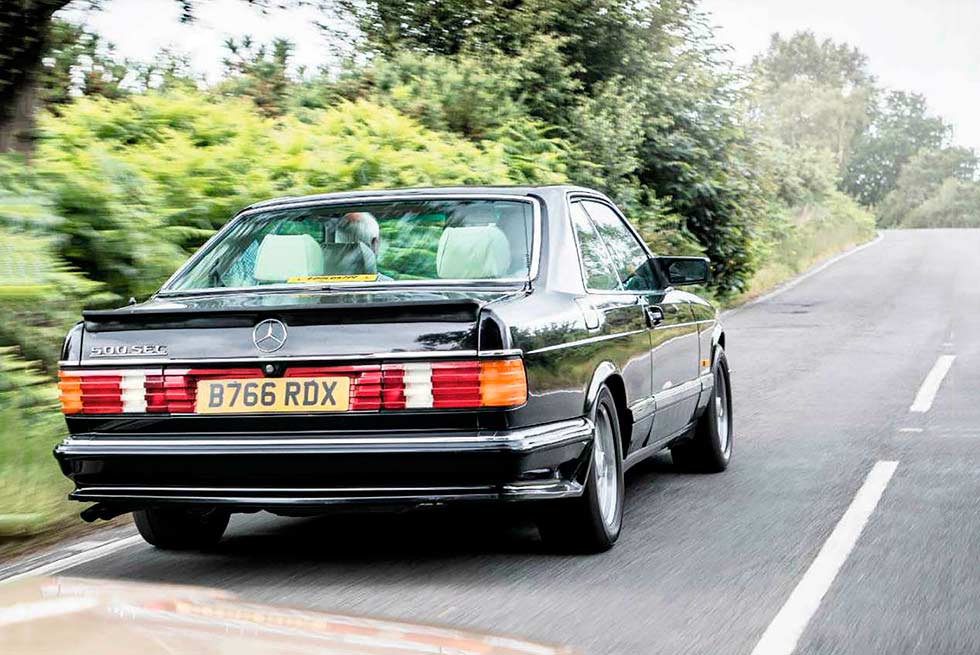

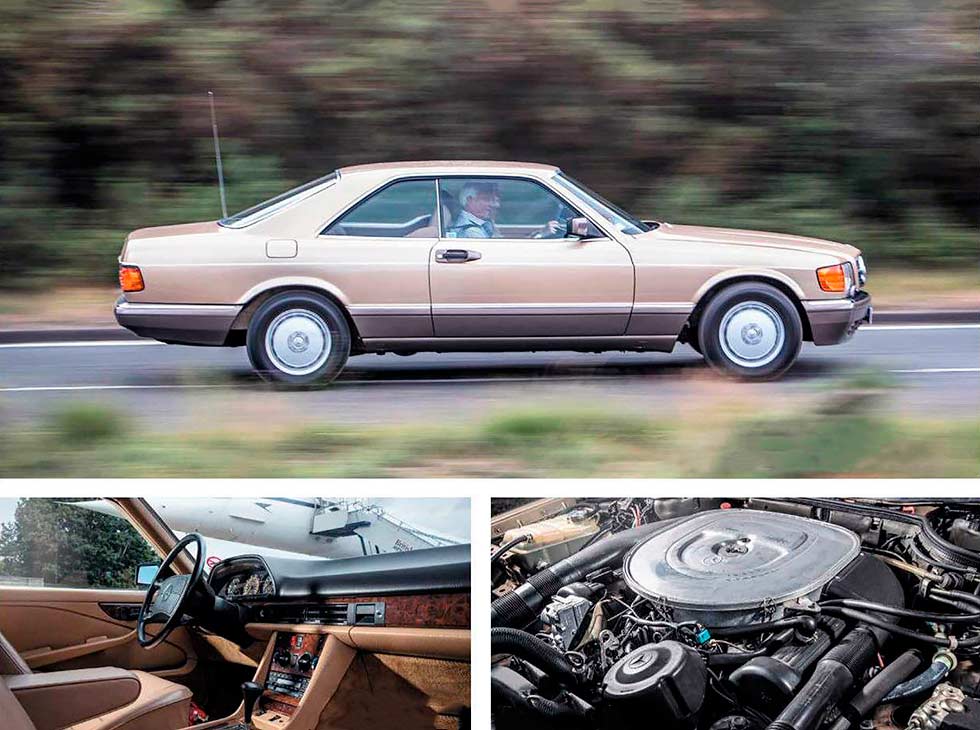
Owning Senna’s 500 SEC
Mike Bruno came to his SEC through a love of motor sport: ‘I got the car in 2006 and it was the Senna link that appealed to me. If it wasn’t for that, it would’ve been scrapped – it was sodden inside, the instrument binnacle was full of mould, and rust had got through the wheelarches and all three layers of the sills. The underside and bonnet were good, so we stripped it back, fixed it and resprayed it. The engine only needed oil in the bores. It still needs work – a bearing in the back of the gearbox went the other day, as has an ABS sensor and a wheel bearing, plus there’s a misfire that might be the coil on its way out. That’s all post-restoration shakedown though, it’s a solid car overall!’
Owning Rosberg’s 500 SEC
Roy Good is a long-term marque devotee: ‘I’ve owned Benzes since 1975 and I’ve never been without one, but this car is something special. I plan to keep it long-term but that comes with costs – I spent £500 a couple of weeks ago checking all the fluids and fixing leaks. You have to keep doing that sort of thing with these cars and there are a couple of little bits and pieces I’d like to sort out. The radio isn’t working and the idle is slightly fast, for example; problems that stem from it being laid up in the 2000s. It started straight up with a fresh battery – we were absolutely amazed! There’s nothing I don’t like about it – it’s lovely to drive, sleek, powerful and really good looking for its age.’





